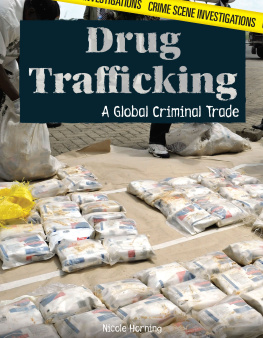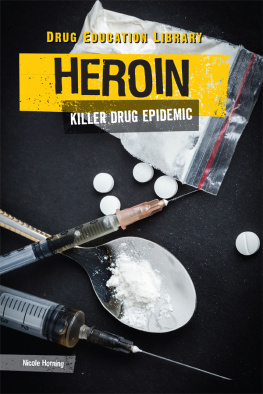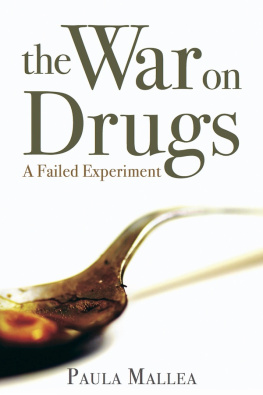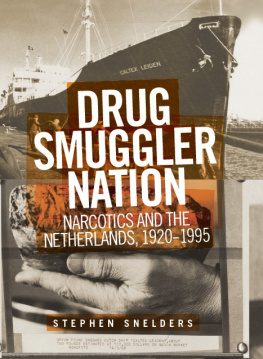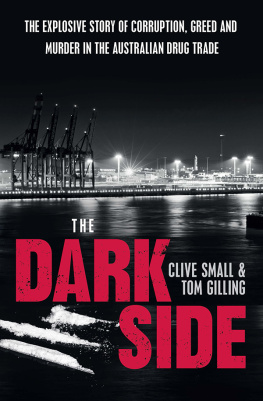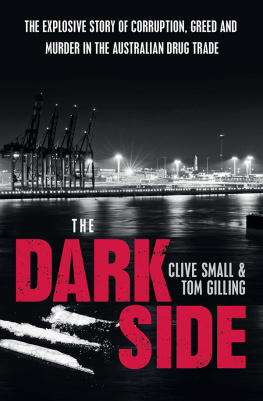- Introduction:
The Global Trade - Chapter One:
The History of the War on Drugs - Chapter Two:
Commonly Trafficked Drugs - Chapter Three:
The Routes of Drug Trafficking - Chapter Four:
Drug Dealing in the 21st Century - Chapter Five:
Efforts to End Drug Trafficking
Published in 2018 by
Lucent Press, an Imprint of Greenhaven Publishing, LLC 353 3rd Avenue Suite 255
New York, NY 10010
Copyright 2018 Lucent Press, an Imprint of Greenhaven Publishing, LLC.
All rights reserved. No part of this book may be reproduced in any form without permission in writing from the publisher, except by a reviewer.
Designer: Deanna Paternostro Editor: Melissa Rae Shofner
Library of Congress Cataloging-in-Publication Data
Names: Horning, Nicole, author.
Title: Drug trafficking : a global criminal trade / Nicole Horning.
Description: First Edition. | New York : Lucent Press, [2018] | Series: Crime scene investigations | Includes bibliographical references and index.
Identifiers: LCCN 2017041826| ISBN 9781534561809 (library bound book) | ISBN 9781534562745 (pbk. book) | ISBN 9781534561793 (ebook)
Subjects: LCSH: Drug traffic. | Drugs. | Drug control.
Classification: LCC HV5801 .H687 2018 | DDC 364.1/3365-dc23 LC record available at https://lccn.loc.gov/2017041826
Printed in the United States of America
CPSIA compliance information: Batch #CW18KL: For further information contact Greenhaven Publishing LLC, New York, New York at 1-844-317-7404.
Please visit our website, www.greenhavenpublishing.com . For a free color catalog of all our high-quality books, call toll free 1-844-317-7404 or fax 1-844-317-7405.
Contents
Introduction:
The Global Trade
Chapter One:
The History of the War on Drugs
Chapter Two:
Commonly Trafficked Drugs
Chapter Three:
The Routes of Drug Trafficking
Chapter Four:
Drug Dealing in the 21st Century
Chapter Five:
Efforts to End Drug Trafficking
Foreword
F or decades, popular television programs and movies have depicted the life and work of police officers, detectives, and crime scene investigators. Many of these shows and films portray forensic scientists as the brains responsible for cracking cases and bringing criminals to justice. Undoubtedly, these crime scene analysts are an important part in the process of crime solving. With modern technology and advances in forensic analysis, these highly trained experts are a crucial component of law enforcement systems all across the world.
Police officers and detectives are also integral members of the law enforcement team. They are the ones who respond to 911 calls about crime, collect physical evidence, and use their high level of training to identify suspects and culprits. They work right alongside forensic investigators to figure out the mysteries behind why a crime is committed, and the entire team cooperates to gather enough evidence to convict someone in a court of law.
Ever since the first laws were recorded, crime scene investigation has been handled in roughly the same way. An authority is informed that a crime has been committed; someone looks around the crime scene and interviews potential witnesses; suspects are identified based on evidence and testimony; and, finally, someone is formally accused of committing a crime. This basic plan is generally effective, and criminals are often caught and brought to justice. Throughout history, however, certain limitations have sometimes prevented authorities from finding out who was responsible for a crime.
There are many reasons why a crime goes unsolved: Maybe a dead body was found too late, evidence was tampered with, or witnesses lied. Sometimes, even the greatest technology of the age is simply not good enough to process and analyze the evidence at a crime scene. In the United States during the 20th century, for example, the person responsible for the infamous Zodiac killings was never found, despite the earnest efforts of hundreds of policemen, detectives, and forensic analysts.
In modern times, science and technology are integral to the investigative process. From DNA analysis to high-definition surveillance video, it has become much more difficult to commit a crime and get away with it. Using advanced computers and immense databases, microscopic skin cells from a crime scene can be collected and then analyzed by a forensic scientist, leading detectives to the home of the culprit of a crime. Dozens of people work behind the scenes of criminal investigations to figure out the unique and complex elements of a crime. Although this process is still time-consuming and complicated, technology is constantly improving and adapting to the needs of police forces worldwide.
This series is designed to help young readers understand the systems in place to allow forensic professionals to do their jobs. Covering a wide range of topics, from the assassination of President John F. Kennedy to 21st-century cybercriminals, these titles describe in detail the ways in which technology and criminal investigations have evolved over more than 50 years. They cite eyewitnesses and experts in order to give a detailed and nuanced picture of the difficult task of rooting out criminals. Although television shows and movies add drama to the crime scene investigation process, these real-life stories have enough drama on their own. This series sticks to the facts surrounding some of the highest-profile criminal cases of the modern era and the people who work to solve them and other crimes every day.

T he United States has been dealing with a major drug problem for more than 40 years. In 1971, President Richard Nixon declared a War on Drugs. Since then, investigators, drug cartels, and the media have been in the middle of that war with seemingly no end in sight. Cartels manufacture drugs that later make their way to individuals who become addicted to them, sometimes with fatal consequences. However, just because these drugs are illegal, it does not stop cartels from producing them, dealers from selling them, or people from using them. For cartels and dealers, the drug business may bring in thousands upon thousands of dollars. Larger cartels, such as the Medellin Cartel or the Cali Cartel, may make millions and even billions of dollars. It is a business people get into for the money, sometimes making thousands in just one day. As legislation changes and police find out how traffickers are getting drugs to individuals, traffickers change their methods. They change how they disguise drugs, using completely new and creative methods to move drugs across the globe. They also use changing technologies to their advantage, using social media websites or Craigslist to sell drugs.
According to the United Nations Office on Drugs and Crime (UNODC), Drug trafficking is a global illicit trade involving the cultivation, manufacture, distribution and sale of substances which are subject to drug prohibition laws.Drug trafficking is typically thought of as being something that occurs only in drug cartels that largely manufacture and distribute drugs across the world. However, drug trafficking also involves the smaller drug rings and drug dealers that put the product out on the streets. To be charged with drug trafficking, the weight of the product is a large factor, as is any drug paraphernalia or businesslike itemsthe trafficker may have business cards, a scale to measure product, or plastic bags to package the product.
Next page
